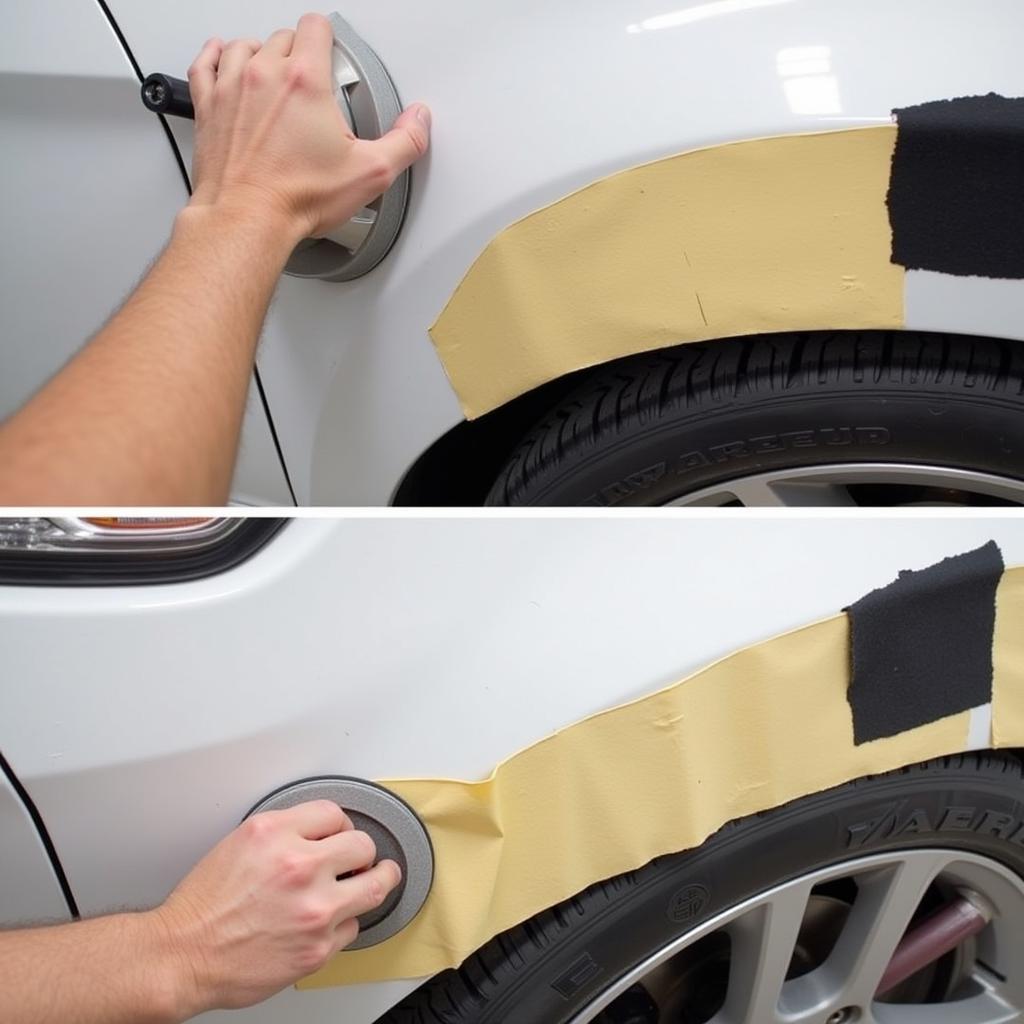Dealing with a big, unsightly scratch on your car can be frustrating. Whether it’s from a keying, a parking lot mishap, or a rogue shopping cart, knowing How To Repair Big Car Scratches can save you a significant amount of money compared to a professional body shop repair. This guide will walk you through the process, offering practical advice and expert tips to help you achieve a near-perfect finish.
Repairing a large scratch effectively depends on its depth. Superficial scratches that only affect the clear coat can often be buffed out with polishing compound. Deeper scratches that penetrate the paint layer, however, require more attention and might involve primer and touch-up paint. For very deep scratches that reach the metal, professional help is often recommended to prevent rust and ensure a proper repair. Knowing how to assess the damage is the first step in successfully repairing big car scratches.
Assessing the Damage and Gathering Your Supplies
Before you start, wash the scratched area thoroughly with car soap and water to remove dirt and debris. Once dry, examine the scratch closely in good lighting. Is it a light surface scratch, a deep gouge, or somewhere in between? This determines the repair method.
For light scratches, you’ll need a polishing compound and a microfiber cloth. Deeper scratches will require sandpaper (various grits), primer, touch-up paint (matched to your car’s color), clear coat, rubbing compound, and polishing compound. Don’t forget masking tape and a clean, soft cloth for applying the paint.
You can often repair small scratches during servicing, as minor imperfections can be easily addressed during a routine maintenance visit. can we repair small car scratches while in servicing
Repairing Light Scratches: The Buffing Method
For minor clear coat scratches, buffing is often sufficient. Apply a small amount of polishing compound to a microfiber cloth and rub it onto the scratch using circular motions. Continue buffing until the scratch disappears, then wipe away any excess compound with a clean cloth. This method is often effective for removing swirl marks and light imperfections as well.
 Buffing Light Car Scratches with Polishing Compound
Buffing Light Car Scratches with Polishing Compound
Repairing Deeper Scratches: Sanding, Priming, and Painting
Deeper scratches require a more involved approach. First, clean the area and mask off the surrounding paint to protect it. Using progressively finer grits of sandpaper (starting with around 1500 grit and working up to 3000 grit), carefully sand the scratched area until it’s smooth and level with the surrounding paint. If the scratch has reached the primer or metal, apply a thin coat of primer to the affected area and let it dry completely.
Next, apply thin coats of touch-up paint, allowing each coat to dry before applying the next. Once the paint is dry, apply a few coats of clear coat, again allowing each coat to dry. Finally, use rubbing compound and polishing compound to blend the repaired area with the surrounding paint, achieving a smooth and seamless finish.
If you are unsure about repairing car body damage yourself, it’s always best to seek professional assistance. how to repair car body damage
 Sanding and Painting a Deep Car Scratch
Sanding and Painting a Deep Car Scratch
Wet Sanding and Polishing for a Flawless Finish
After the clear coat has dried for at least 24 hours, wet sand the area with very fine grit sandpaper (3000 grit or higher) to remove any imperfections and orange peel. Then, polish the area with polishing compound and a microfiber cloth to restore the shine. This final step is crucial for achieving a professional-looking repair.
Learning how to repair silver car paint can be particularly challenging due to its reflective nature. how to repair silver paint of the car
 Wet Sanding and Polishing a Repaired Car Scratch
Wet Sanding and Polishing a Repaired Car Scratch
Conclusion
Repairing big car scratches can be a DIY project if you have the right tools, patience, and attention to detail. Remember to assess the damage carefully, choose the appropriate repair method, and follow the steps diligently. While a perfect repair might require professional expertise, especially for deep scratches, you can achieve impressive results with a little effort. By following the steps outlined in this guide, you can restore your car’s appearance and save yourself a considerable amount of money.
FAQ
-
Can I use any type of paint for touch-ups? No, you need touch-up paint specifically matched to your car’s color code.
-
What if the scratch is too deep to repair myself? Consult a professional auto body shop for deep scratches that reach the metal.
-
How long does the repair process take? It depends on the severity of the scratch, but it can range from a few hours to a full day.
-
What can I do to prevent car scratches? Be mindful of where you park, avoid tight spaces, and consider using a car cover.
-
Is it necessary to use primer? Primer is essential for deep scratches that reach the metal or primer layer to prevent rust and ensure proper paint adhesion.
-
Can I wet sand without a polishing compound afterward? Wet sanding creates a dull finish, so polishing is necessary to restore the shine.
Do you have a chipped or cracked windshield? Check our guide on how to repair car front glass
Need help with other car repairs? Check out our other articles on our website.
Need assistance? Contact us via WhatsApp: +1(641)206-8880, or Email: [email protected]. Our customer service team is available 24/7.


